In industrial, commercial, and residential systems, maintaining optimal pressure levels is crucial for efficient operation and the longevity of the infrastructure. This is where pressure reducing valves (PRVs) play a pivotal role, designed to reduce a higher inlet pressure to a manageable and constant outlet pressure. However, like all mechanical components, PRVs are not immune to failure. Understanding what happens when a pressure reducing valve fails is essential for operators, maintenance personnel, and system designers alike, as the implications can range from minor inconveniences to catastrophic failures.
The Role of Pressure Reducing Valves
Before delving into the consequences of their failure, it’s important to reiterate the role of pressure reducing valves. PRVs are control valves that reduce the input pressure of a fluid to a desired value at its output, ensuring that downstream equipment operates within safe and efficient pressure parameters. This is achieved through a mechanism that adjusts the valve opening based on downstream pressure feedback, allowing more or less fluid to pass through the valve based on the desired set point.

Consequences of Pressure Reducing Valve Failure
The failure of a pressure reducing valve can manifest in several ways, each with distinct consequences for the system it serves. The severity and impact of these failures depend on the specific application, the nature of the fluid being controlled, and the system’s design.
- Overpressure Downstream
The most immediate and potentially hazardous consequence of PRV failure is overpressure in the downstream system. If a PRV fails to reduce the pressure adequately, the downstream equipment and piping will be subjected to pressures they are not designed to withstand. This can lead to equipment damage, seal failures, leaks, and in extreme cases, pipe bursts or catastrophic system failures. Overpressure can also pose serious safety risks to personnel, especially in systems handling hazardous materials.
- Underpressure Downstream
Conversely, a PRV can fail in such a way that it restricts the flow too much, leading to insufficient pressure downstream. This underpressure scenario can cause process inefficiencies, inadequate flow rates, and system malfunctions. In water distribution systems, for example, this could result in inadequate water supply to consumers or fire suppression systems. In industrial processes, it could lead to suboptimal operation or shutdown of process equipment.
- Oscillation and System Instability
Failure of a PRV can also result in pressure oscillations, where the outlet pressure fluctuates above and below the desired set point. This instability can be due to wear and tear, improper valve sizing, or feedback loop issues. Oscillations can cause erratic system behavior, increased wear on equipment, and in some cases, resonance phenomena that can severely damage the system.
- Increased Maintenance and Operational Costs
A failing PRV can significantly increase maintenance and operational costs. Frequent breakdowns necessitate repairs and replacements, while system inefficiencies due to improper pressure control can lead to increased energy consumption and reduced equipment lifespan. The downtime associated with addressing PRV failures can also lead to lost production and revenue in industrial settings.
- Safety Risks
The safety risks associated with PRV failure cannot be overstated. Overpressure conditions can lead to leaks or explosions, especially in systems handling flammable, toxic, or corrosive fluids. These incidents can result in environmental damage, legal liabilities, and, most tragically, injury or loss of life.
Diagnosing and Mitigating PRV Failure
To mitigate the consequences of PRV failure, it’s important for system operators to implement regular maintenance schedules, conduct periodic system audits, and invest in training for personnel. Understanding the signs of impending valve failure, such as abnormal noises, leaks, or pressure fluctuations, can allow for proactive intervention before a minor issue escalates into a major failure.
Conclusion
The failure of a pressure reducing valve in any system is not a matter to be taken lightly. Its consequences can range from minor operational inefficiencies to severe safety hazards, highlighting the critical role these valves play in ensuring the safe and efficient operation of pressure-dependent systems. Through diligent maintenance, proper sizing and selection, and an understanding of the warning signs of valve failure, operators can significantly reduce the risk of such failures and their potentially devastating consequences. In the complex dance of pressure control within industrial and residential systems, the PRV plays a crucial role, and its integrity is paramount to the harmony of the entire system.






